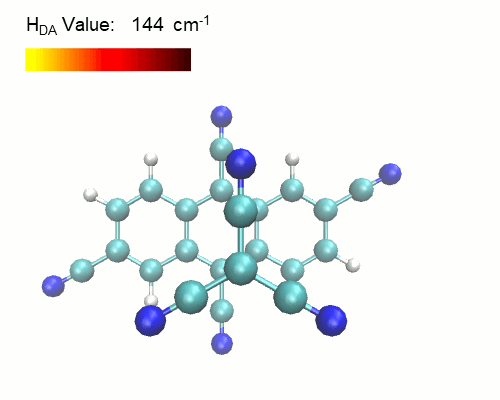What Affects the Electronic Coupling (HDA) between Two Molecules?
The electronic coupling matrix element between the electron acceptor and donor, HDA, is a key parameter determining the electron transfer rate in the Marcus theory. In order to study how the relative acceptor-donor orientation and separation will affect HDA, we put together a photo-excited electron acceptor, 4,6,9,10-tetracyanoanthracene, and an electron donor, tricyanomethanide, and computed HDA between them using an effective 2-state Generalized Mulliken-Hush theory.
(1) Molecular rotation
The two molecules are placed in a cofacial arrangement, the separation between them is set to be 0.5 nm. HDA is calculated when the donor is rotated within its plane relative to the acceptor.

The following graph shows the relationship between the calculated HDA and the rotation angle. The red dots represent HDA between the locally excited state and a charge transfer state having the largest oscillator strength with the locally excited state. The blue dots are HDA between locally excited state and the lowest charge transfer state.

(2) In-plane translation of the molecule
HDA is also calculated as the donor is translated in the plane. Results show that HDA is very sensitive to the motion of the molecule.


This 2-D contour plot shows the HDA value regarding to where the center of tricyanomethanide is.

(3) The distance between two molecules
We also studied the effect of molecular separation, with the relative molecular orientation being fixed. The following graphs show that HDA drops exponentially regarding to the distance between the acceptor and the donor.

In conclusion, the electronic coupling is very sensitive to the relative orientation between the electron donor and acceptor. If the relative orientation is fixed, HDA decays exponentially regarding to the distance between the molecules.
More details about this topic can be found in our publication:
Boning Wu, Mark Maroncelli and Edward W. Castner, Jr., “Photoinduced Bimolecular Electron Transfer in Ionic Liquids.”, J. Am. Chem. Soc., 2017, 139, 14568–14585, doi: 10.1021/jacs.7b07611.
Thank you for reading this article. Please don't hesitate to email me if you have any questions.